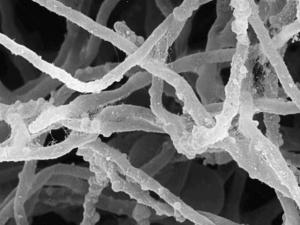Phanerochaete chrysosporium
A Microbial Biorealm page on the genus Phanerochaete chrysosporium
Classification
Higher order taxa
Eukaryota; Fungi/Metazoa group; Fungi; Dikarya; Basidiomycota; Agaricomycotina; Agaricomycetes; Agaricomycetes incertae sedis; Corticiales; Corticiaceae; Phanerochaete
Species
|
NCBI: Taxonomy |
Phanerochaete chrysosporium
Description and significance
Phanerochaete chrysosporium is the model white rot fungus because of its specialized ability to degrade the abundant aromatic polymer lignin, while leaving the white cellulose nearly untouched. Phanerochaete chrysosporium releases extracellular enzymes to break-up the complex three-dimensional structure of lignin into components that can be utilized by its metabolism. The extracellular enzymes are non-specific oxidizing agents (hydrogen peroxide, hydroxyl radicals) used to cleave the lignin bonds. [3]
Due to Phanerochaete chrysoporium specialized degradation abilities, extensive research is seeking ways to understand the mechanism in order to enhance the bioremediation of a diverse range of pollutants. Therefore, Phanerochaete chrysosporium is the first member of the Basidiomycetes to have its complete genome sequenced. [6]
Genome structure
Phanerochaete chrysoporium’s genome consists of approximately 29.6-million base pairs arranged in ten linear chromosomes [6]. Genomic analysis provides structural, comparative, and functional information about the organisms.
P. chrysoporium’s importance in the field of biotechnology lead to the analysis P450 monooxygenase genes to provide information about the complex protein interactions and distinct components involved in the production of the polyaromatic degrading extracellular enzyme. In the P450 genes, microexons were detected to suggest the mechanisms of alternative splicing during transcription, which may explain this organism’s evolution of diverse metabolic activity. [7]
Cell structure and metabolism
Phanerochaete chrysosporium is a crust fungi, which forms flat fused reproductive fruiting bodies instead of the mushroom structure. This fungi exhibit an interesting pattern of septate hyphae, giving a stronger line of defense in times of distress. The hyphae network has some branching, with diameters ranging from 3-9 µm. At the ends of the hyphae rests chlamydospores, thick-walled spores varying from 50-60 µm. The conidiophore gives rise to round asexual blastoconidia, which are 6-9 µm in diameter. [1,2]
Degradation of lignin and polutants is made possible by the production of extracellular enzymes. Components such as lignin peroxidase and manganese peroxidase take part in the remediation of various pesticides, polyaromatic hydrocarbons, PCBs, TNT, carbon tetrachloride and various poisons.
Metabolism of Lignin
Reseach in the degradation of lignin has resulted in numerous substituted benzene ring products. An important catalyst in these reactions is phenol-oxidizing enzymes.
Ecology
Due to Phanerochaete chrysosporium sustainability at moderate to higher temperatures, specifically 40 degrees celcius, this white-rot fungus can be found in forests ranging from North America, to areas of Europe and in Iran. [4] A main role it assumes is that of degradation of the complex lignin from various trees and plants. This process reduces lignin into less complex molecules, maintaining the cycle of the decomposer of plants.
Recent studies have revealed an association of a certain bacteria found in conjunction with this strain of fungi. Agrobacterium radiobacter was isolated as coexisting with the fugi, and very difficult to separate. [5] Discovery of how bacteria and fungi affect each other physiologically is yet to be conclusive, but further research could give further evidence of mutualism, and its affect on bioremdiation.
Pathology
Phanerochaete chrysosporium is a saprophytic fungus capable of organic breakdown of the woody part of dead plants. Therefore, plants that are in the process of dieing or dead serve as an optimal substrate for P. chrysosporium. Symptoms may include white patches of cellulose due to the disappearance of lignin from the plant structure.
This fungus is not a known pathogen of humans or animals.
Application to Biotechnology
Does this organism produce any useful compounds or enzymes? What are they and how are they used?
Current Research
Finding a way to degrade everyday plastics has been a concern for sometime now. Research has shown Phanerochaete chrysosporium to be a degrader of phenolic resins found in such plastics within particle board and Formica, the constitutent of many counters and table tops. Research ensues as other types of fungi are found to be inclined to degrade complex components of plastic. Tom Volk's Fungus of the Month for February 2007
References
1. Burdsall, H. (1985) Mycologia Memoir 10, 61-63.
2. Nakasone, K. (1990) Mycologia Memoir 15, 224-225.
3. Burdsall, H. (1974) Mycotaxon 1, 124.
4. Burdsall, H. (1985) Mycologia Memoir 10, 61-63
5. F. Seigle-Murandi, P. Guiraud, J. Croize, E. Falsen, and K. L. Eriksson, "Bacteria Are Omnipresent on Phanerochaete chrysosporium Burdsall." "Applied and Environmental Microbiology Journal." 1996 July; 62(7): p.2477–2481.
6. Martinez D et al., "Genome sequence of the lignocellulose degrading fungus Phanerochaete chrysosporium strain RP78.", Nat Biotechnol, 2004 Jun;22(6):695-700
7. Doddapaneni, Harshavardhan, Ranajit Chakraborty, and Jagjit Yadav. "Genome-Wide Structural and Evolutionary Analysis of the P450 Monooxygenase Genes (P450ome) in the White Rot Fungus Phanerochaete Chrysosporium : Evidence for Gene Duplications and Extensive Gene Clustering." BMC Genomics 6 (2005). 9 Mar. 2008.
Edited by student of Kate Scow

![Degradation of a dead tree by Phanerochaete chrysosporium; Mag. .5x. Photograph courtesy of [1]](/images/c/c1/Whiterot.jpg)
